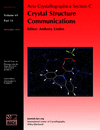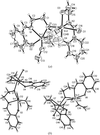issue contents
November 2013 issue
Special issue on Pharmaceuticals, drug discovery and natural products
Guest Editor: Professor Christopher S. Frampton (Pharmorphix, Cambridge, England)

Cover illustration: The structure of carbamazepine trifluoroacetic acid monosolvate overlaid on its difference Fourier map [see Eberlin, Eddleston & Frampton (2013). Acta Cryst. C69, 1260-1266]. The paper forms part of the special issue on Pharmaceuticals, drug discovery and natural products.
editorial
Free 

An overview of current topics of interest in the field of solid-state pharmaceuticals and an introduction to papers featured in this special issue.
pharmaceuticals and natural products
Download citation


Download citation


Density functional theory (DFT) NMR prediction, 1H–1H Total Correlated Spectroscopy (TOCSY) NMR and single-crystal X-ray crystallography were used to confirm the formation of a bis-cyclopentenyl-β-cyanohydrin in preference to a 2,3,6,7-dehydrodecalin-β-cyanohydrin as the kinetic product upon subjecting tri- and tetraene substrates to Ru-catalyzed alkene metathesis.
Download citation


Download citation


Glabridin is a species-specific biomarker from the roots Glycyrrhiza glabra L. (European licorice, Fabaceae). Stereochemical analysis, including circular dichroism, NMR data and an X-ray diffraction data set with Bijvoet differences, confirms that glabridin, purified from its natural source, is found only in a C3 R configuration.
Download citation


Download citation


A new polymorph of the pharmaceutically active sulfapyridine derivative N-(6-methylpyridin-2-yl)mesitylenesulfonamide was obtained as a phase-pure product from methanol. The molecules adopt the conformation which is predicted for an individual molecule by force field calculations.
CCDC reference: 920529
Download citation


Download citation


High-resolution diffraction data support our interpretation that the title compound is coordinated by two ammine rather than by an ammine and an aqua ligand.
Download citation


Download citation


The preparation, single-crystal X-ray structure and solution-state NMR analysis of (±)-threo-ritalinic acid, obtained from the hydrolysis of the methyl ester (±)-threo-methyl phenidate, are reported.
CCDC reference: 936328
Download citation


Download citation


The isostructural crystal structures of cefradine dihydrate and cefaclor dihydrate, based on experimental data where available and supplemented with dispersion-corrected density functional theory calculations, are presented. The crystal structures are typical examples of isolated-site hydrates.
Download citation


Download citation


Gaboxadol hydrochloride (also known as THIP hydrochloride) undergoes a reversible single-crystal-to-single-crystal transformation at 221 K. Crystal structures have been determined at 298 and 220 K.
Download citation


Download citation


(+)-6-Aminopenicillanic acid, a precursor of a variety of semi-synthetic penicillins, represents an ordered zwitterion and the crystals are nonmerohedrally twinned. The complementary analysis of the crystal packing by the PIXEL method brings to light the nature and ranking of the energetically most stabilizing intermolecular interaction energies.
CCDC reference: 962282
Download citation


Download citation


This report illustrates the crystal structures of three new inhibitors targeting the mycobacterial regulator EthR which has previously been identified as a novel target for tuberculosis drug boosters. In addition, we describe how the results of our structure determination were used to develop a docking protocol using GOLD for future in silico screening.
Solving pharmaceutical crystal structures from powder diffraction data is discussed in terms of both the various methodologies that have been applied and the complexity of the structures that have been solved.
Download citation


Download citation


Methanesulfonic acid salt forms of carbamazepine and 10,11-dihydrocarbamazepine have been prepared and characterized by a number of analytical techniques, including single-crystal X-ray diffraction at 100 K. The structural data for these complexes were analysed in relation to data derived from other carbamazepine complexes and a redetermination of the apparently anomalous trifluoroacetic acid solvate structure was undertaken.
Download citation


Download citation


The molecules in the title cocrystal are present in their neutral forms, and assemble a molecular layer by means of hydrogen bonding. Differences in the environments of the isonicotinamide molecules were assessed by Hirshfeld surface analysis.
CCDC reference: 968754
Download citation


Download citation


The structure determination of loxapine succinate and its monohydrate is presented. Fixed cell geometry optimization using density functional theory in CASTEP was used as a complementary tool to locate the H-atom positions in the crystal structure determined from X-ray powder diffraction data.
Download citation


Download citation


Proton transfer systematically producing molecular salts is used in a study of nine molecular complexes of bromanilic acid with methylpyridines, which show predictable synthons related to the stoichiometry and a common N—H⋯O charge-assisted hydrogen bond.
inorganic compounds
Download citation


Download citation


The title compounds were prepared via a mechanochemical reaction in the solid state. They crystallize in the NaSc(BH4)4 structure type composed of isolated [Yb(BH4)4]− anions, with Yb coordinated tetrahedrally by BH4 groups, surrounded by M+ cations (M = Na, K) which form distorted trigonal prisms.
Download citation


Download citation


Crystals of MgCl2·8H2O, MgCl2·12H2O, MgBr2·6H2O, MgBr2·9H2O, MgI2·8H2O and MgI2·9H2O were grown from their aqueous solutions at temperatures below 298 K according to the solid–liquid phase diagrams. All structures are built up from Mg(H2O)6 octahedra. Dimensions and angles in the hexaaqua cation complexes are very similar and variation is not systematic.
Download citation


Download citation


Rietveld refinement of Na9Sc(MoO4)6 shows that its structure is made up of clusters formed from an ScO6 octahedron and three Na1O6 octahedra sharing total edges. The clusters are connected by sharing vertices with bridging MoO4 tetrahedra, forming a three-dimensional framework.
CCDC reference: 967055
metal-organic compounds
Download citation


Download citation


In the title organic–inorganic hybrid material, the tetrachloridozincate anions and 1-cyclohexylpiperazine-1,4-diium dications are interconnected via N—H⋯Cl and C—H⋯Cl hydrogen bonds to form layers parallel to the (001) plane. The cyclohexyl groups are located between these layers to form an infinite three-dimensional network.
CCDC reference: 962782
Download citation


Download citation


A novel cadmium complex consists of one-dimensional ladders constructed from [Cd2(COO)2] dimeric subunits. A combination of hydrogen bonding and π–π stacking interactions extend the one-dimensional ladders into a three-dimensional supramolecular architecture.
Download citation


Download citation


The title compound is a two-dimensional network containing an –Mn—O—C—O—Mn– chain. Each layer presents a herringbone pattern and interacts with neighbouring layers through intermolecular hydrogen bonds.
CCDC reference: 960924
Download citation


Download citation


A three-dimensional metallohelicate is constructed from one-dimensional metal–organic helices of purine-containing 3-(6-oxo-6,9-dihydro-1H-purin-1-yl)propionate ligands and zinc(II) ions.
CCDC reference: 960968
Download citation


Download citation


3,4-Dihydroxy-1,6-bis(4-methoxyphenyl)hexa-2,4-diene-1,6-dione exhibits the di-enol-dione tautomeric form and is compared with its 4-methylphenyl analogue. In a potassium salt of 2-hydroxy-4-(4-methoxyphenyl)-4-oxobut-2-enoic acid, the organic species are linked by a strong hydrogen bond between the carboxylic acid and carboxylate groups.
Download citation


Download citation


Two novel inorganic–organic coordination polymers, based on NaI cations with semi-rigid V-shaped dicarboxylate ligands, have been prepared and structurally characterized.
Download citation


Download citation


In a novel three-dimensional CdII complex prepared by hydrothermal assembly of Cd(NO3)2·4H2O, 1,4-bis[2-(pyridin-4-yl)ethenyl]benzene and 2,2′-(1,4-phenylene)diacetic acid, each CdII centre is located in a distorted pentagonal bipyramidal coordination environment. The three-dimensional net can be regarded as a diamondoid network by treating the CdII atoms as nodes and the benzene and diacetic acid ligands as linkers.
CCDC reference: 964523
Download citation


Download citation


A one-dimensional polymeric structure of CdII with sulfaquinoxaline is further stabilized by intermolecular hydrogen bonding. The fluorescence spectrum reveals that the complex emits strong blue fluorescence. The thermal analysis shows that the framework is stable up to 663 K.
CCDC reference: 964428
Download citation


Download citation


A dinuclear tin(IV) complex of 2-[(2-oxidobenzylidene)amino]ethanolate is disordered above 178 K. The crystal structure at 93 K contains two ordered molecules. The phase transition corresponds to an order–disorder transition of a vinyl group bound to the SnIV atom.
Download citation


Download citation


A novel anionic tubular CdII coordination polymer based on the 5-(carboxylatomethoxy)benzene-1,3-dicarboxylate ligand and containing 4-aminopyridinium cations had been synthesized under hydrothermal conditions. In the solid state, the 4-aminopyridinium cation props up the structure through hydrogen bonds to the O-atom acceptors of ligands and solvent water molecules.
CCDC reference: 962876
Download citation


Download citation


The layered polymeric structure of a benzene-1,2,4,5-tetracarboxylate–Cu complex forms parallelogram-shaped channels.
CCDC reference: 963370
Download citation


Download citation


In a dinuclear zinc(II) complex of acetate and 6-chloro-2-{(E)-[(pyridin-2-yl)methylimino]methyl}phenolate, the ZnII cations differ in their five-coordinate geometries, with one adopting a distorted trigonal bipyramidal geometry and the other a square-pyramidal geometry.
CCDC reference: 964546
Download citation


Download citation


Double nitrile⋯π interactions are relevant for the crystal packing of charge-diffuse conjugated tetracyanopropenide anions when combined with common heteroaromatic tris-chelate octahedral complexes, [Fe(phen)3]2−.
CCDC reference: 964427
Download citation


Download citation


The Cu atoms in the title complexes are five-coordinated in distorted trigonal bipyramidal environments by four N atoms of two 5,5′-dimethyl-2,2′-bipyridine ligands and one N atom of a dicyanamide anion, which is coordinated in a monodentate manner in the equatorial plane. The structures are stabilized by C—H⋯N and C—H⋯X hydrogen bonds (X = F and O) and π–π interactions between pyridine rings.
Download citation


Download citation


Two five-coordinated aquacopper(II) centres chelated to pyridine-2,6-dicarboxylate terminal ligands are bridged by a 1,2-bis(pyridin-3-yloxy)ethane spacer. The structure includes a well-resolved cyclic water tetramer, which acts as a subunit to form a larger aggregate.
CCDC reference: 966113
Download citation


Download citation


The crystal structures of bis(4-methylanilinium) and bis(4-iodoanilinium) pentamolybdates were determined using laboratory X-ray data and refined by total energy minimization methods. The obtained structures present alternating organic cation and inorganic polyanion layers bound by weak bonding (apart from ionic interactions).
Download citation


Download citation


A novel infinite one-dimensional coordination polymer involving N′-(2-hydroxybenzylidene)-2-(naphthalen-2-yloxy)acetohydrazide, and a trinuclear nickel complex of 2-hydroxy-N′-(2-oxo-2-phenoxyethyl)benzohydrazide with a one-dimensional network structure constructed by hydrogen-bonding interactions, are reported.
Download citation


Download citation


In a mononuclear NdIII complex, three chelating 2,4-dioxo-1,2,3,4-tetrahydropyrimidine-5-carboxylate ligands and three aqua ligands build up a distorted monocapped square antiprism around the cation. A complex hydrogen-bonding network results in a densely packed structure (packing index = 77.7%)
CCDC reference: 965871
organic compounds
Download citation


Download citation


A series of N-(2-phenylethyl)nitroaniline derivatives is presented, demonstrating that modest changes in the functional groups cause significant differences in molecular conformation, intermolecular interactions and packing.
Download citation


Download citation


Proline (Pro) exists in its neutral form in N-acetyl-L-proline monohydrate and is zwitterionic in N-benzyl-L-proline. The presence of a water molecule in the neutral form and the difference in the ionization states between the two forms have effected significant changes in the respective intermolecular schemes.
Download citation


Download citation


Three N-[2-(pyridin-2-yl)ethyl]-substituted sulfonamides are almost structurally identical, the most dramatic different being seen for the N—C—C—C torsion angle with the introduction of a methyl group in the para position of the sulfonamide moiety. These compounds are prospective ligands for the formation of new metal complexes.
Download citation


Download citation


The structures of two 6-aminouracil dimethylacetamide monosolvates and a 1-methylpyrrolidin-2-one monosolvate display N—H⋯O hydrogen-bonding patterns that link the uracil molecules to their respective solvent molecules. The formation of  (8) N—H⋯O hydrogen-bond motifs between 6-aminouracil molecules can only be found in two-dimensional frameworks, whereas
(8) N—H⋯O hydrogen-bond motifs between 6-aminouracil molecules can only be found in two-dimensional frameworks, whereas  (14) N—H⋯O patterns are present when zigzag chains of 6-aminouracil molecules are formed.
(14) N—H⋯O patterns are present when zigzag chains of 6-aminouracil molecules are formed.
Download citation


Download citation


The crystal structure of a potent glycogen phosphorylase a (GPa) inhibitor (IC50 of 6.3 µM) consists of four distinct conjugated π systems separated by rotatable bonds around the Csp3 atoms. The molecules are linked into dimers disposed about a crystallographic centre of symmetry through a cyclic N—H⋯O hydrogen-bonding motif.
CCDC reference: 967059
Download citation


Download citation


The absolute configuration of the enantiopure anti-head-to-head cyclodimer of anthracene-2-carboxylic acid was determined. The dimer interacts with L-prolinol through a nine-membered hydrogen-bonded ring [ (9)], while a dichloromethane molecule is incorporated to fill the void space.
(9)], while a dichloromethane molecule is incorporated to fill the void space.
CCDC reference: 966795
addenda and errata
Free 



 journal menu
journal menu




























































